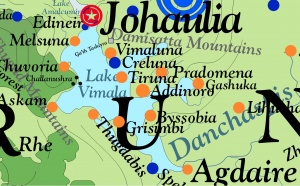Lake Vimala
The highland lake of the Republic of Johaulia has been honored since antiquity as one of the sacred springs of creation and a dwelling-place for the gods and their minions. Lake Vimala /vih-~MAH-la/ was sacred in turn to ancient Kalama, ancient Midretasso, during the Yophenthean Empire, and for modern-day Johaulia. The name Vimala originates from the ancient Kalaman name of the god Bhimala, the divinity that is believed to occupy and preside over the body of water.
Bounded on all sides by steep or sloping hills, the lake receives water from the Plateau of Midretasso and drains through a system of locks and dikes into the sea, pouring down the Great Cataracts of Liluthio across from the City of Johaulia into Lake Amalcumir. The surface of Lake Vimala rests at 3.8 DF (613 meters or 2011.15 feet) above sea level. In the twenty seventh century (2619), The lake's depth was measured to at least 2.075 DF (334 meters or 1096 feet) deep towards its center. Lake Vimala is about 171 ddwmir (112 km or 70 miles) long at its greatest extent. One of the principal tongues of land that reaches into the lake from the east is Takshuhona Peninsula on the tip of which rests the historic city of Addinoro (Aturoksha).
The lake waters temper the climate so that winters are mild and summers moderately warm. Cypress and pines speckle the shores which enjoy abundant rainfall in the winter, spring, and autumn. The climate is known as 'mediterranean rainforest.'
Temples and shrines dot the coastline of the lake and legends recount the exploits of the god Liluthio and other divinities who are thought to inhabit the waters or visit the surrounding hills.
The city of Addinoro (Aturoksha) is home to the Temple of Atur of the Great Flood, the traditional guardian divinity of the lake, regarded as the offspring of the goddess Vahmu and the god Hesukh. The other famous shrine is the Temple of Lord Vimal of the Pilgrims which rests on a stone pediment above the water line of Lake Vimala just off the shore of the city.
By tradition, there are fifteen most sacred temples associated with Lake Vimala. Pilgrims often will visit all or most of these temples.
Tradition and History
In ancient times, lake dragons threatened the peace of voyagers and residents, until heros of the Midretassene Empire slew all water-dwelling dragons centuries ago, most notably the semi-divine hero, Addan, for which the city of Addinoro (Aturoksha) was renamed.
Climate
The climate is generally rainy, with heavy rains in early spring and late summer. Snow is extremely rare on the shores of the lake. Winter rains are gentle and unceasing. Cities and sites along the west coast of Lake Vimala receive less rain. Rains are usually due to large weather systems dumping precipitation onto the plateau of central Corundy and mountain effect rain on the eastern shore of the Lake and weather systems hit the Damisatta Mountains. These rains along with the lake's depth serve to keep it full through the millennia despite the drainage through the water falls of the north.
Transportation
The lake easily affords itself to transportation throughout the central territory of the republic and has done so since ancient times. Boats, barges, and even rafts ensure that the humblest person is not limited to his home town. Commercial traffic is typical on the western shore of the lake, bearing wares between Agdaire in the south and Johaulia to the north.
See Also
- City of Johaulia
- Corundy
- Damisetta Mountains
- Great Cataracts of Liluthio
- Great Valley of Lord Vimal
- Lake Amalcumir
- Republic of Johaulia
- Vimal
| This article is a stub. It requires further development by the creator. |
